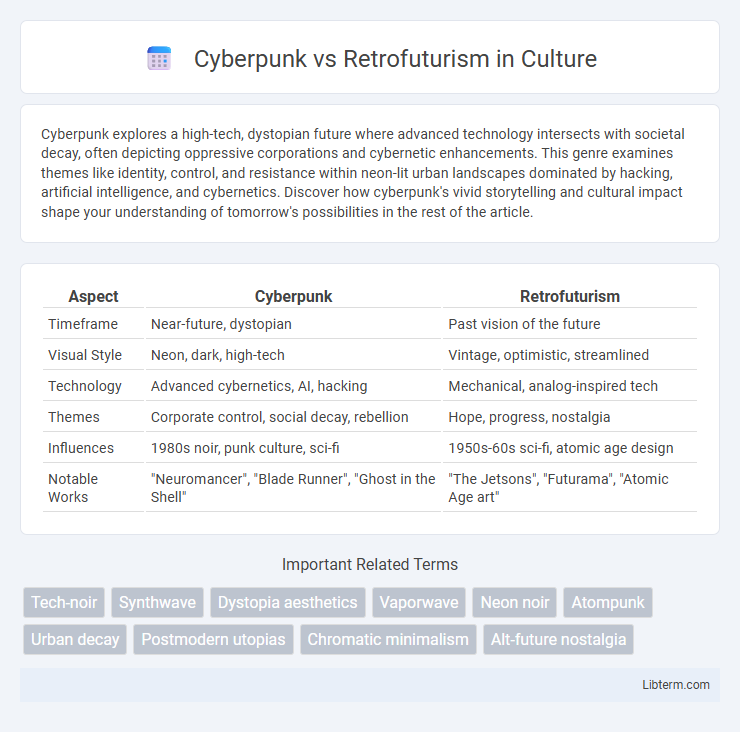Cyberpunk explores a high-tech, dystopian future where advanced technology intersects with societal decay, often depicting oppressive corporations and cybernetic enhancements. This genre examines themes like identity, control, and resistance within neon-lit urban landscapes dominated by hacking, artificial intelligence, and cybernetics. Discover how cyberpunk's vivid storytelling and cultural impact shape your understanding of tomorrow's possibilities in the rest of the article.
Table of Comparison
| Aspect | Cyberpunk | Retrofuturism |
|---|---|---|
| Timeframe | Near-future, dystopian | Past vision of the future |
| Visual Style | Neon, dark, high-tech | Vintage, optimistic, streamlined |
| Technology | Advanced cybernetics, AI, hacking | Mechanical, analog-inspired tech |
| Themes | Corporate control, social decay, rebellion | Hope, progress, nostalgia |
| Influences | 1980s noir, punk culture, sci-fi | 1950s-60s sci-fi, atomic age design |
| Notable Works | "Neuromancer", "Blade Runner", "Ghost in the Shell" | "The Jetsons", "Futurama", "Atomic Age art" |
Defining Cyberpunk: Origins and Characteristics
Cyberpunk originated in the early 1980s as a subgenre of science fiction, characterized by its focus on high-tech advancements juxtaposed with societal decay and dystopian urban settings. It features protagonists who are often anti-heroes navigating corrupt corporations, cybernetic enhancements, and pervasive digital networks, emphasizing themes of rebellion and inequality. Influential works like William Gibson's "Neuromancer" established cyberpunk's iconic visual and narrative motifs, including neon-lit cityscapes, hacking culture, and cybernetic body modifications.
What is Retrofuturism? A Historical Overview
Retrofuturism is an artistic and cultural movement that explores futuristic visions from the past, blending nostalgic elements with speculative technology and design motifs from the mid-20th century. It often features streamlined aesthetics, chrome finishes, and optimistic portrayals of space travel and advanced machinery inspired by the 1950s and 1960s. This genre contrasts sharply with Cyberpunk's dystopian narratives by emphasizing idealized futures reflecting the hopes and anxieties of earlier eras.
Visual Aesthetics: Neon Noir vs. Vintage Futurism
Cyberpunk visual aesthetics are defined by neon noir elements such as glowing signs, dark urban environments, and high-contrast lighting that create a gritty, futuristic atmosphere. Retrofuturism, on the other hand, embraces vintage futurism with pastel colors, streamlined shapes, and chrome finishes inspired by mid-20th century visions of the future. Both styles use futuristic themes but diverge in tone, with cyberpunk highlighting dystopian realism and retrofuturism celebrating optimistic, nostalgic interpretations of tomorrow.
Key Themes: Dystopia, Utopia, and Beyond
Cyberpunk explores dystopian themes characterized by high-tech decay, corporate dominance, and societal collapse, reflecting fears of a surveillance-heavy future plagued by inequality. Retrofuturism envisions utopian or hopeful futures influenced by mid-20th-century optimism, blending nostalgic aesthetics with advanced technology to imagine harmonious human-machine integration. Both genres examine humanity's relationship with technology, but while cyberpunk warns of dehumanization and loss of control, retrofuturism inspires innovation through idealized visions of progress and societal improvement.
Inspirations: Influences Shaping Both Genres
Cyberpunk draws heavily from the dystopian visions of authors like William Gibson and films such as Blade Runner, emphasizing high-tech, low-life settings influenced by rapid technological advancements and urban decay. Retrofuturism takes inspiration from mid-20th century design, science fiction, and optimistic technological speculation, showcasing how past eras imagined the future with elements like streamlined architecture, flying cars, and classic robots. Both genres reflect cultural anxieties and aspirations but differ in their historical references and aesthetic interpretations of future technology.
Iconic Works: Films, Art, and Literature
Cyberpunk's iconic works include William Gibson's novel *Neuromancer*, Ridley Scott's film *Blade Runner*, and the anime *Akira*, all showcasing dystopian futures with advanced technology and gritty urban settings. Retrofuturism is exemplified by the art of Syd Mead, the optimistic vision in *The Jetsons* TV series, and novels like *The Difference Engine* by William Gibson and Bruce Sterling, highlighting alternate histories with vintage futuristic design. Both genres influence visual aesthetics and storytelling, with cyberpunk emphasizing high-tech and low-life motifs, while retrofuturism blends nostalgic styles with imagined futures.
Societal Commentary: Technology and Culture
Cyberpunk critiques the fusion of advanced technology with dystopian societies, highlighting issues such as corporate control, surveillance, and social inequality. Retrofuturism reflects nostalgia for past visions of the future, often romanticizing technological optimism while revealing cultural anxieties about progress and change. Both genres use technology as a lens to explore societal dynamics, but cyberpunk emphasizes gritty realism and systemic decay, whereas retrofuturism blends hope and critique through a vintage aesthetic.
Fashion and Style: From Cybernetic Chic to Atomic Age
Cyberpunk fashion embodies futuristic cybernetic aesthetics with neon-lit accessories, leather, and tech-infused garments symbolizing dystopian urban life. Retrofuturism style draws inspiration from the Atomic Age, featuring streamlined silhouettes, metallic fabrics, and bold geometric patterns reflecting mid-20th-century optimism about the future. Both genres merge imagination and culture but contrast sharply between gritty cybernetic chic and nostalgic, space-age elegance.
Fan Communities and Subcultures
Cyberpunk fan communities thrive on exploring dystopian futures marked by high-tech and socio-economic decay, often engaging in immersive role-playing and digital art creation that reflect themes of corporate control and cybernetic enhancement. Retrofuturism subcultures celebrate nostalgic visions of the future from past decades, emphasizing vintage aesthetics, classic sci-fi media, and DIY crafting that emphasize optimism and analog technology. Both fan bases cultivate vibrant online forums and conventions, fostering distinct yet overlapping cultural expressions that influence fashion, music, and visual arts within the broader speculative fiction landscape.
The Future of Cyberpunk and Retrofuturism
The future of cyberpunk envisions a fusion of hyper-advanced technology and dystopian societies, emphasizing themes like artificial intelligence, cybernetics, and corporate dominance while exploring the impact on human identity and social structures. Retrofuturism projects a future through the lens of past aesthetics, blending nostalgic design elements from the mid-20th century with speculative technology, forecasting innovations that reflect cultural optimism and analog influences. Both genres will evolve by integrating immersive media and AI-driven storytelling, shaping futuristic narratives that challenge modern perceptions of progress and technology.
Cyberpunk Infographic

 libterm.com
libterm.com